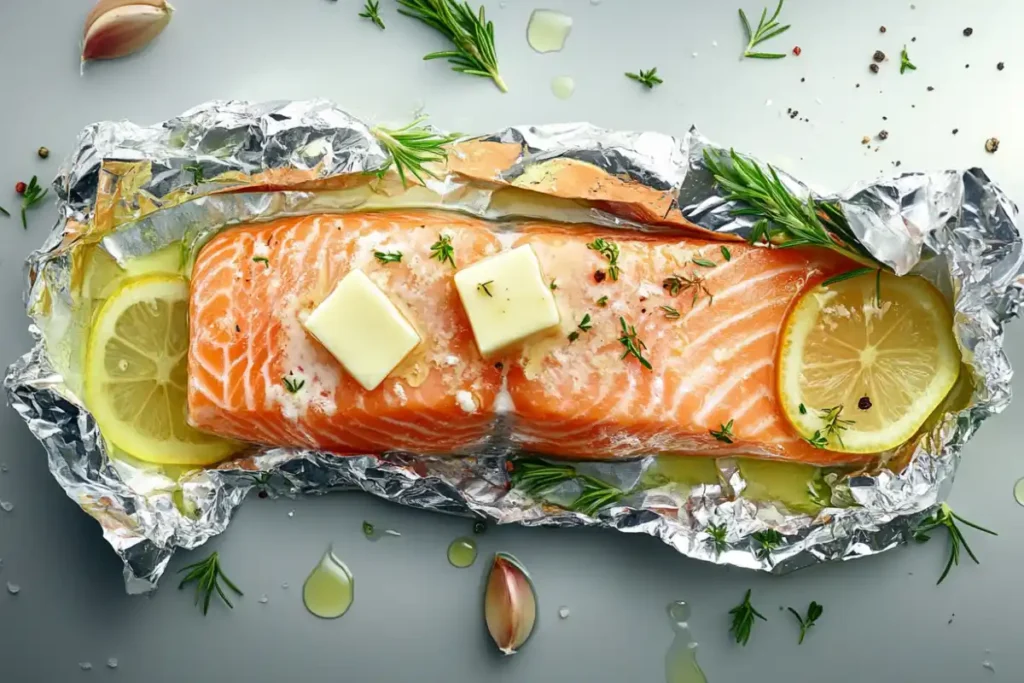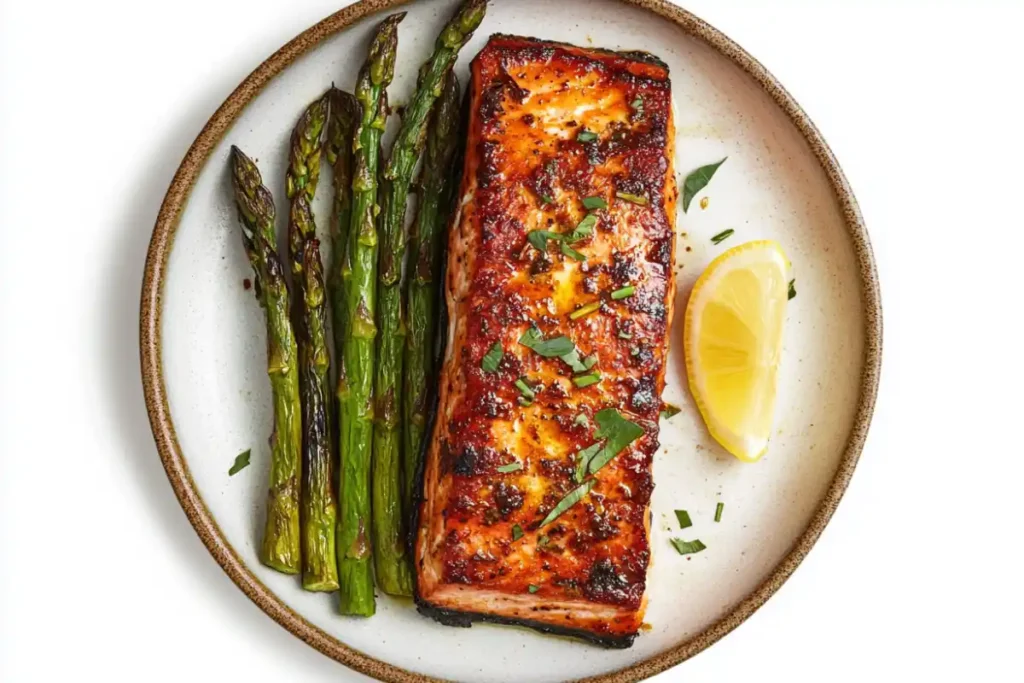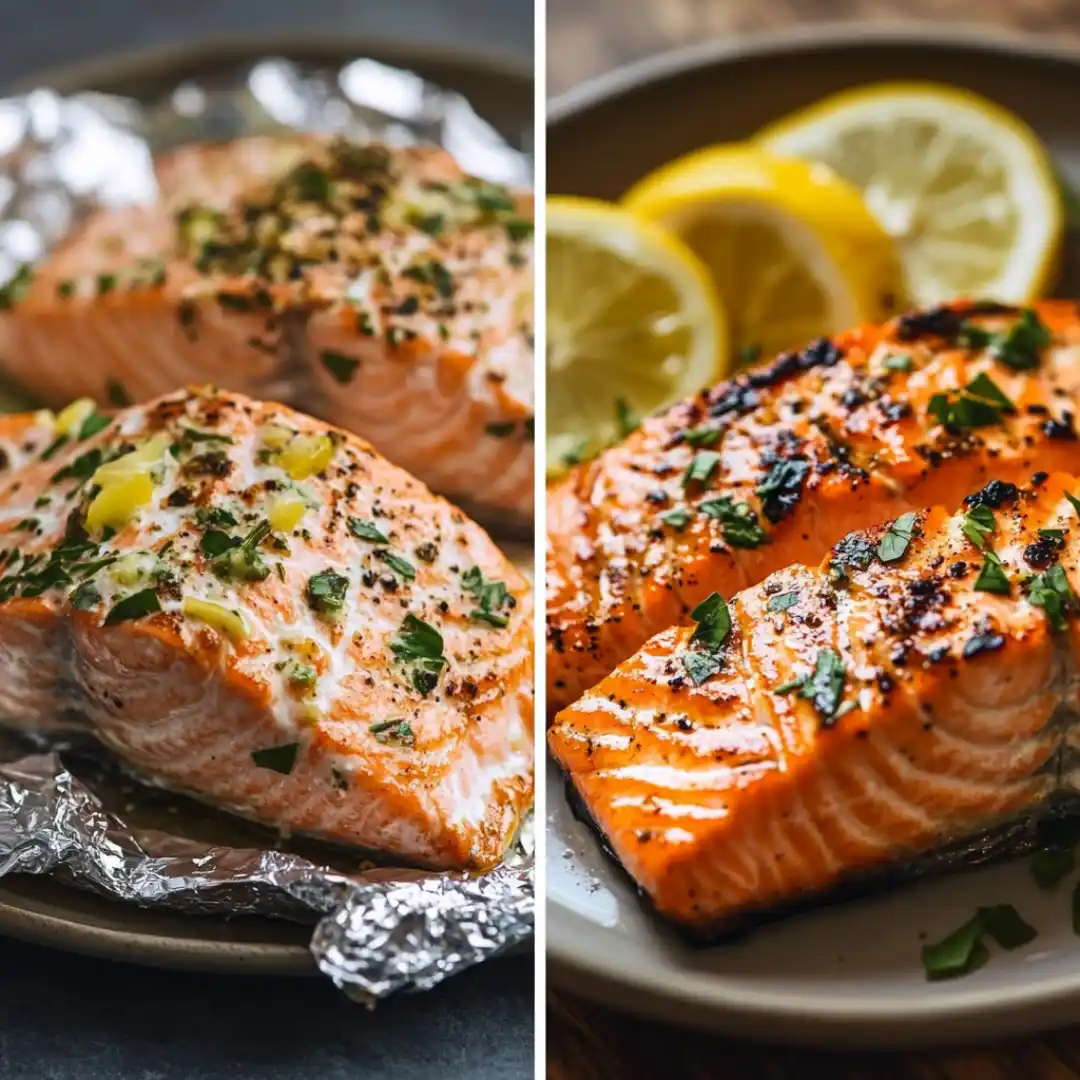Is Salmon Better in Foil or No Foil? A Complete Guide for Home Cooks
Cooking salmon is like walking a fine line, you want it juicy and flaky, but not overcooked or bland. One big question pops up time and time again: Is salmon better in foil or no foil? It’s a fair debate, and depending on who you ask, you’ll get different answers. Some folks swear by the steamy tenderness that foil provides, while others chase that crispy skin you can only get without it.
In this article, we’ll break down both methods side by side, from flavor and texture to health, prep time, and cleanup. We’ll also share expert tips, compare recipes, and help you decide which method suits your needs best. So, whether you’re a kitchen newbie or a seasoned home cook, this guide’s got you covered.
Introduction to Salmon Cooking Methods
Why the Foil Debate Matters
Salmon is a fan favorite in kitchens everywhere. It’s fast, nutritious, and flavorful, whether you’re making a fancy dinner or a weeknight meal. But here’s where things get dicey: should you wrap it in foil or not? This simple decision can totally change how your salmon turns out.
Wrapping salmon in foil traps in moisture, giving you soft, flaky fish that’s almost impossible to mess up. It’s like a built in steamer. Plus, it helps seal in seasonings like garlic, lemon, or herbs, turning every bite into a flavor bomb. On the flip side, no foil means the fish gets direct heat, which is great for browning the top and crisping up the skin, especially if you’re pan searing or broiling it.
So yeah, it’s more than just a cooking technique. It’s about taste, texture, and personal preference. Knowing when to foil and when to go foil-free can elevate your salmon game from “meh” to mouthwatering.
Overview: What We’ll Cover in This Guide
In this guide, we’ll explore:
- The pros and cons of both methods
- How flavor and texture compare
- The best scenarios for each cooking style
- Tips for keeping salmon moist and tasty
- Popular salmon recipes with foil and without
- FAQs like “Can you cook salmon without foil?” and “What’s the healthiest way to cook salmon?”
By the end, you’ll know exactly how to answer the big question: Is salmon better in foil or no foil?
Cooking Salmon in Foil: Pros and Cons
Moisture Retention and Tenderness: Why Foil Shines
When it comes to baking fish, foil is often a lifesaver, especially for beginners. Wrapping salmon in foil helps seal in moisture, creating a steamy environment that gently cooks the fish from the inside out. The result? Tender, juicy, flaky salmon that’s hard to overcook. This method is ideal if you’re aiming for soft textures and clean flavors.
Also, foil acts like a flavor bomb. Anything you toss in, lemon, garlic, herbs, butter, gets trapped with the fish and infuses deeply. No extra steps, no fancy tools, just simple, delicious flavor locked into every bite.
For those wondering Is salmon better in foil or no foil?, foil often wins when you’re short on time and want consistent results.
Foil as a Flavor Infuser: Herbs, Citrus, and Garlic Benefits

One of the best perks of foil baked salmon is how it absorbs the seasonings. Toss in rosemary, dill, or parsley, add a few lemon slices, drizzle some olive oil, and boom, you’ve got a flavor-infused salmon dinner that tastes like it came from a restaurant.
Better yet, cleanup is almost nonexistent. Just toss the foil afterward, no scrubbing, no soaking.
Still, there are trade offs…
Drawbacks of Using Foil: Soggy Skin and Lack of Crisp Texture
While foil is foolproof, it does have its downsides. For starters, if you’re a fan of crispy salmon skin, foil’s not your friend. The trapped steam keeps everything moist, including the skin, which often ends up soggy.
Plus, if you’re going for that caramelized edge or golden crust, foil won’t get you there. It shields the fish from direct heat, meaning you lose out on the beautiful browning you’d get on the grill or in a pan.
So, foil has its charm, but it’s not perfect for every palate.
Cooking Salmon Without Foil: Pros and Cons
Direct Baking, Grilling, or Pan Searing: More Texture, More Flavor
Cooking salmon without foil opens the door to some delicious possibilities. When the fish meets direct heat, whether from a grill, a pan, or even a hot oven, you get that irresistible sear, slightly crisp edges, and sometimes even a smoky finish. If you’re aiming for crispy salmon skin, going foil-free is the way to go.
For example, grilling salmon without foil is a favorite among chefs and backyard BBQ lovers alike. The high heat creates a rich, charred crust while the inside stays moist if you watch the timing. Add a dry rub or Asian inspired marinade, and you’re in flavor heaven.
Downsides of No Foil: Drying Out, Less Forgiving
That said, cooking without foil can be risky. Salmon is lean and delicate, leave it on the heat a minute too long, and you could end up with something tough and dry. Without the moisture barrier that foil provides, every second matters.
Also, cleanup becomes a chore. Whether it’s grease splatter in your oven or fish bits stuck to your grill, going foil-free usually means a bit more elbow grease.
Best Practices for Cooking Salmon Without Foil
If you’re ditching the foil, use these smart moves to avoid dry fish:
- Brush your salmon with oil or melted butter to lock in moisture.
- Cook on a hot surface to quickly sear the outside while protecting the interior.
- Always preheat your grill, skillet, or oven for even cooking.
- Use a meat thermometer to avoid overcooking, pull it at around 135°F and let it rest.
So again, we return to the big question: Is salmon better in foil or no foil? The answer depends on what you’re after, moist tenderness or that irresistible crispy finish.

Expert Tips for Both Methods
How to Prevent Overcooking: Thermometer and Timing Tricks
No matter which cooking method you choose, foil or no foil, overcooking is the enemy. Salmon cooks fast, and even a few extra minutes can dry it out. The easiest way to prevent that? Use an instant-read thermometer.
Aim to pull your salmon from the heat when it reaches about 135°F. Don’t worry, it’ll keep cooking as it rests. This trick works great whether you’re wrapping it in foil or grilling it straight on the grate.
Don’t have a thermometer? Look for flaking. If the fish separates easily with a fork and looks a little translucent in the center, it’s good to go. And always let it rest a few minutes before serving, it helps the juices settle.
Common Mistakes to Avoid with Each Method
Let’s be real, plenty can go wrong. With foil, the most common mistake is oversteaming. If your packet is too tight or loaded with moisture, your salmon can turn mushy instead of moist. Loosen it up and don’t overdo the lemon juice or wine.
Going foil free? Don’t skip the oil. Without it, the salmon might stick and tear apart. Also, never use cold salmon straight from the fridge, it cooks unevenly. Let it rest at room temperature for about 10 minutes before cooking.
Remember, when asking Is salmon better in foil or no foil?, the outcome often depends on how well you avoid these rookie mistakes.
Flavor and Texture Comparison: Which Tastes Better?
Taste Test: Foil vs. No Foil
Here’s where things get deliciously subjective. When you bake salmon in foil, the flavor is delicate and moist. The herbs and citrus get steamed right into the fish. It’s subtle, elegant, and balanced, perfect if you’re into clean, fresh flavor profiles.
Now, if you love bold textures, no foil might be your jam. A little char from the grill or a crispy pan-seared edge can bring out rich, caramelized flavors you simply can’t get from foil. It’s punchier, more rustic, and adds a whole new layer of depth.
So again, Is salmon better in foil or no foil? If you prefer tender, infused fish, go with foil. But if you crave crispy edges and robust flavor, skip the wrap.
Which Method Brings Out More Natural Flavor of Salmon?
Surprisingly, that depends on your taste buds. Foil tends to preserve the natural flavor of the salmon, letting the fish shine through. It’s excellent if you’ve got a beautiful wild caught fillet and want to taste its pure essence.
In contrast, no foil methods let you play with texture and browning, which can add flavor complexity, but might slightly mask the salmon’s original taste.
So, there’s no one size fits all answer. It’s all about what you want on your plate.
For more delicious recipes, check out our grilled salmon guide.
Health and Nutrition Considerations
Does Cooking in Foil Affect Nutrition?
Here’s the good news, cooking salmon in foil doesn’t reduce its nutritional value. The foil acts more like a protective shell, helping to lock in nutrients instead of letting them escape through evaporation or dripping into a pan. So you’ll still get all the omega-3 fatty acids, lean protein, and essential vitamins salmon is famous for.
That said, some people worry about aluminum leaching into food during cooking. While the science is still mixed, the risk is low, especially if you line the foil with parchment paper or avoid acidic ingredients like lemon touching the foil directly.
Skin On vs. Skin Off: What’s Healthier and Tastier?
Leaving the skin on during cooking, whether you use foil or not, helps retain moisture and adds healthy fats. Plus, crispy skin can be downright tasty if cooked right.
So, Is salmon better in foil or no foil? From a health view, both are solid choices, as long as you use fresh, quality fish and simple ingredients.
Best Situations for Foil vs. No Foil
When to Use Foil: Busy Weeknights, One Pan Meals, Beginner Cooks
There’s a time and place for foil, and it’s usually when you need dinner fast without the fuss. Foil is your best friend on hectic weeknights, it’s easy, mess-free, and super forgiving. You can prep everything in one go, toss it in the oven, and walk away.
It’s also great for beginners. If you’re nervous about drying out your salmon, foil gives you a cushion. It’s hard to overcook salmon when it’s surrounded by moisture and steam.
Camping or cooking on a grill? Foil makes transport and cleanup a breeze.
When to Skip the Foil: Impressing Guests, Crispy Skin Lovers
Now, if you’re cooking for guests or just want to impress yourself, skip the foil. Direct heat gives your salmon a golden crust and that to die for crispy skin. It’s ideal for fancy dinners, date nights, or when you’re simply craving bold flavor and texture.
So, Is salmon better in foil or no foil? It really depends on the occasion. Want easy cleanup and moisture? Go with foil. Craving texture and a crispy finish? Ditch it and cook your salmon bare.
Popular Recipes and Techniques
Top Recipes for Foil Baked Salmon (Pesto, Lemon Herb, Garlic Butter)
If you’re looking for recipes where foil really shines, try salmon baked with lemon and rosemary, garlic butter, or even pesto. These versions let the juices, herbs, and oil soak into the fish, giving you big flavor without needing extra sauces. You can toss everything into the foil packet, seal it up, and pop it in the oven, dinner’s ready in 20 minutes, tops.
Foil is also perfect for layering extras like asparagus, tomatoes, or baby potatoes right alongside your salmon. It turns into a full, healthy meal without extra dishes.
Bonus? It’s pretty much foolproof. That’s why many folks ask, Is salmon better in foil or no foil?, especially when they’re after easy, mess free cooking.
Top Recipes Without Foil (Pan Seared, Broiled, Cedar Plank Grilled)
Now, if texture is your thing, no foil methods open up a lot of delicious doors. Pan-seared salmon with crispy skin is a crowd favorite, it’s rich, golden, and ready in minutes. Broiling gives a great char, while grilled salmon on a cedar plank adds a smoky kick you can’t beat.
These techniques give you stronger flavors and bolder textures. Sure, they might need a bit more effort, but for many, the payoff is totally worth it.
Verdict: Is Salmon Better in Foil or No Foil?
Final Comparison and Recommendation Based on Cooking Goals
So, let’s settle the big question: Is salmon better in foil or no foil?
If you’re looking for tender, moist salmon with simple prep and cleanup, foil is the way to go. It’s ideal for beginners, busy nights, and those who love subtle, herb infused flavors. On the other hand, if you’re craving bold taste, crispy edges, or that satisfying sear, go no foil.
Neither option is “wrong”, they’re just different tools for different kitchen goals. Think of foil as the comfort zone, and foil free methods as the flavor frontier.
Choose Your Method Based on Time, Taste, and Tools
Ask yourself: Do I want a low effort meal with zero cleanup? Use foil. Do I have the time to cook carefully and clean up afterward? Go foil free.
In the end, Is salmon better in foil or no foil? Only your taste buds can decide. But now, at least, you’ve got the knowledge to cook it both ways, perfectly.
FAQs from People Also Ask
Is it better to bake salmon covered or uncovered?
It depends on your goal. Covered (with foil) salmon locks in moisture, giving you juicy, evenly cooked fillets, great for delicate textures. Uncovered baking works best if you want a slightly crisp top or golden edges. If you’re still unsure and wondering is salmon better in foil or no foil?, start with foil, then broil for a minute to get the best of both worlds.
Can you cook salmon without foil?
Absolutely! You can grill, broil, pan sear, or roast salmon without foil. Just keep a close eye on the timing, and be sure to oil your pan or grate to prevent sticking. Cooking without foil brings out deeper, richer flavors, especially if you enjoy crispy skin.
Why wrap salmon in foil when baking?
Foil is like a personal steam room for your fish. It keeps all the moisture inside, preventing the salmon from drying out. It also traps the seasonings, creating a flavor-packed experience without much fuss. That’s a big reason why many people prefer foil when asking is salmon better in foil or no foil?
What is the best way to keep salmon moist?
The key is to avoid overcooking it. Whether you use foil or not, pull your salmon off the heat when it hits about 135°F. Let it rest for a few minutes to finish cooking. Adding a touch of olive oil or butter also helps keep things juicy.
Conclusion
So, what’s the final verdict on that burning question: Is salmon better in foil or no foil? The truth is, it depends on what you’re cooking for.
Foil delivers moist, mess free meals with gentle flavor. No foil brings bold textures and a richer, crispier finish. Either way, when cooked right, salmon is one of the healthiest, most versatile proteins out there.
Now it’s your turn. Try both methods, mix and match your seasonings, and find your personal favorite. Then, come back and share your results. Which one won your heart (and your taste buds)?
Happy cooking, and happy experimenting!
